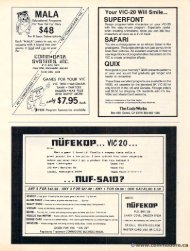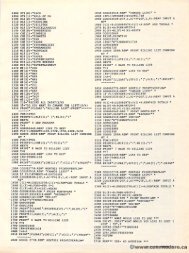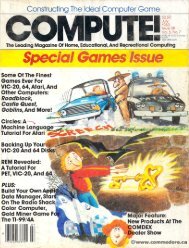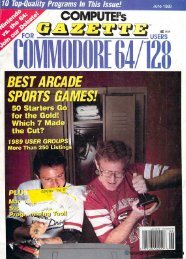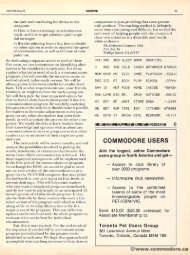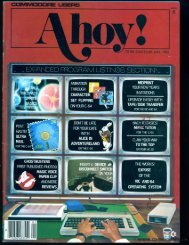May June 1980 - Commodore Computers
May June 1980 - Commodore Computers
May June 1980 - Commodore Computers
Create successful ePaper yourself
Turn your PDF publications into a flip-book with our unique Google optimized e-Paper software.
,<br />
A<br />
rt\\>sALL<br />
~\uS'ALL NEW from MICRO-ED!<br />
x<br />
MICRO-DOZEN TWO<br />
• AGREEMENT OF SUBJECT AND VERB<br />
AGREEMENT OF SUBJECT AND VERB<br />
(Elementary and up)<br />
Problems consist of sentences with missing<br />
verbs. Two verb choices (singular and plural)<br />
are provided for each problem. The e learner types<br />
the correct form of the verb.<br />
• RUN-ON SE NTENCES (Elementary)<br />
RUN-ON SENTENCES (Elementary)<br />
Each problem consists of a group of words that<br />
should be divided into two sentences. Using the<br />
space bar, bar. the learner moves an arrow across the<br />
screen and places it after the word that should<br />
end the first sentence.<br />
• MAKE A SENTENCE (First Grade)<br />
MAKE A SENTENCE (First Grade)<br />
Some scrambled scrambted words appear on the screen.<br />
The learner teamer must use some of these words (but<br />
only onty these words) to type a complete sentence.<br />
• MORE WORD DEMONS: ITS-IT'S-YOUR<br />
MORE WORD DEMONS: ITS-IT'S-YOUR-<br />
YOU'RE (Elementary and up)<br />
Each lesson consists of twenty problems. There<br />
are sentences with blanks to be filled by the ap·<br />
propriate homonyms. At the end of the lesson.<br />
lesson,<br />
the learner'S learner's performance is summarized. Among<br />
other things, this summary lists the specific homo·<br />
nyms that may have given the learner trouble<br />
during the lesson.<br />
• HIGHER, SAME, LOWER (Elementary Music)<br />
HIGHER, SAME, LOWER (Elementary Music)<br />
Each lesson consists of ten problems in which<br />
two notes are played. Is !s the second not'e note higher<br />
than, , lower than, , or the same as the first note?<br />
Each pair of notes is randomly selected from a<br />
bank of sixty·seven sixty-seven pairs.<br />
• MATCHING RHYTHMS (Elementary Music)<br />
MATCHING RHYTHMS (Elementary Music)<br />
The computer randomly selects one of ten rhy·<br />
thmic patterns and plays this as it displays match·<br />
ing quarter notes and eighth notes on the screen.<br />
The learner attempts to match the rhythm by<br />
pressing the space bar.<br />
• TARGET MATH (Elementary)<br />
TARGET MATH (Elementary)<br />
The learner er selects problems in addition, addition. sub·<br />
traction, traction. multiplication, plication. or division at a difficulty<br />
level of his. / her choice. A target area appears at<br />
the bottom of the screen, screen. along with a math prob·<br />
lem. . When the learner types an answer, answer. a plane<br />
flies over and a parachute jumper floats down over<br />
the landing strip. If the jumper hits the target<br />
area, area. the next problem is presented<br />
• WORKING WITH BASIC MULTIPLICATION<br />
FACTS (Elementary)<br />
Each lesson consists of fifteen problems. If the<br />
learner wishes, wishes. he/ she may practice multiplying<br />
by a certain number. Problems are posed at ran·<br />
dom and are not repeated unless they are missed.<br />
• WORKING WITH BASIC ADDITION<br />
WORKING WITH BASIC ADDITION<br />
FACTS (Primary Grades)<br />
Each lesson consists of fifteen problems. If the<br />
learner wishes, wishes. he/ 'she may practice adding only<br />
a certain number. Problems are posed at random<br />
and are not repeated unless they are missed.<br />
• ADDING OR SUBTRACTING TWO-AND<br />
ADDING OR SUBTRACTING TWO-AND-<br />
THREE-PLACE NUMBERS IN COLUMNS<br />
(Elementary)<br />
This program presents addition or subtraction<br />
problems using two·and·three·place two-and-three-place numbers in<br />
columns. The learner works with each problem<br />
beginning with with the units column on the right. right, (as<br />
would be done with paper and pencil) pencil} and moving<br />
left as guided by an arrow displayed under the<br />
appropriate column.<br />
• SUBTRACTING WITH OBJECTS<br />
SUBTRACTING WITH OBJECTS<br />
(Primary Grades)<br />
Each lesson presents ten randomly generated<br />
subtraction problems with numbers from one to<br />
ten being subtracted from each other. Small<br />
arrows and diamond shapes represent this opera·<br />
tion.<br />
• ADDING WITH OBJECTS (Primary Grades)<br />
Each lesson presents ten randomly generated<br />
addition problems with sums up to twenty. Small<br />
diamond shapes representing the numbers to be<br />
added appear on the screen.<br />
• Punctuation Series<br />
AII12 All Tapes for $84,00<br />
$84.00<br />
AVAILABLE this SUMMER<br />
• Synonym Series<br />
• Punctuation Series<br />
• Reading Racer Series<br />
• Vocabulary Series<br />
Details concerning these new series available upon request<br />
Details concerning these new series available upon request.<br />
We welcome suggestions for educational programs.



